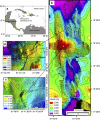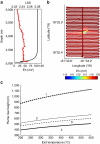Hydrothermal vent fields and chemosynthetic biota on the world's deepest seafloor spreading centre
- PMID: 22233630
- PMCID: PMC3274706
- DOI: 10.1038/ncomms1636
Hydrothermal vent fields and chemosynthetic biota on the world's deepest seafloor spreading centre
Abstract
The Mid-Cayman spreading centre is an ultraslow-spreading ridge in the Caribbean Sea. Its extreme depth and geographic isolation from other mid-ocean ridges offer insights into the effects of pressure on hydrothermal venting, and the biogeography of vent fauna. Here we report the discovery of two hydrothermal vent fields on the Mid-Cayman spreading centre. The Von Damm Vent Field is located on the upper slopes of an oceanic core complex at a depth of 2,300 m. High-temperature venting in this off-axis setting suggests that the global incidence of vent fields may be underestimated. At a depth of 4,960 m on the Mid-Cayman spreading centre axis, the Beebe Vent Field emits copper-enriched fluids and a buoyant plume that rises 1,100 m, consistent with >400 °C venting from the world's deepest known hydrothermal system. At both sites, a new morphospecies of alvinocaridid shrimp dominates faunal assemblages, which exhibit similarities to those of Mid-Atlantic vents.
Figures





References
-
- Corliss J. B. et al.. Submarine thermal springs on the Galapagos Rift. Science 203, 1073–1083 (1979). - PubMed
-
- Haymon R. et al.. Hydrothermal vent distribution along the East Pacific Rise crest (9°09–9°54 N) and its relationship to magmatic and tectonic processes on fast-spreading mid-ocean ridges. Earth Planet Sci. Lett. 104, 513–534 (1991).
-
- Edmond J. M. et al.. Ridge crest hydrothermal activity and the balances of the major and minor elements in the ocean: the Galapagos data. Earth Planet Sci. Lett. 46, 1–18 (1979).
-
- Hannington M. D., Jonasson I. R., Herzig P. M. & Petersen S. Physical and chemical processes of seafloor mineralization at mid-ocean ridges. in Seafloor Hydrothermal Systems: Physical, Chemical, Biological and Geological Interactions (eds Humphris S.E., Zierenberg R.A., Mullineaux L.S. & Thomson R.E.) 115–157 (Geophysical Monograph Series 91, AGU, 1995).
-
- Desbruyères D., Segonzac M. & Bright M. Handbook of Deep-Sea Vent Fauna 2nd edn (Denisia 18, Biologiezentrum Linz, 2006).
Publication types
MeSH terms
Associated data
- Actions
- Actions
- Actions
LinkOut - more resources
Full Text Sources

